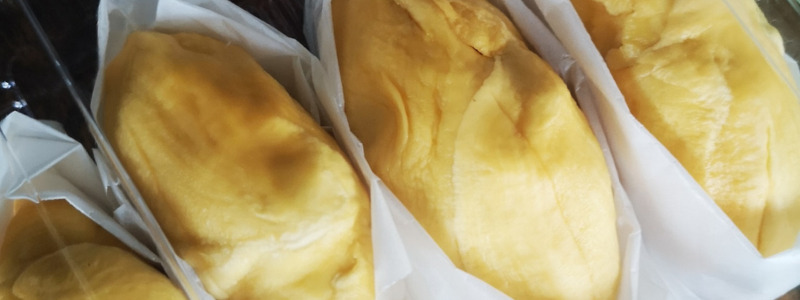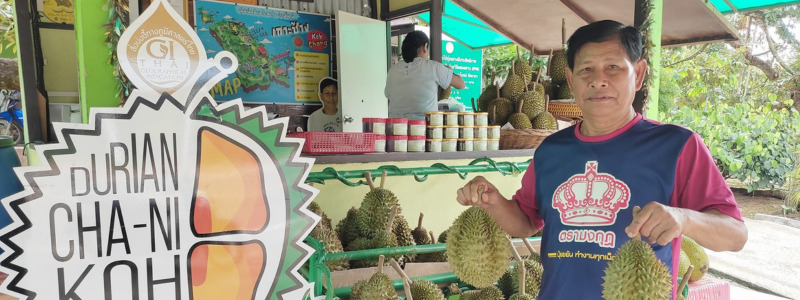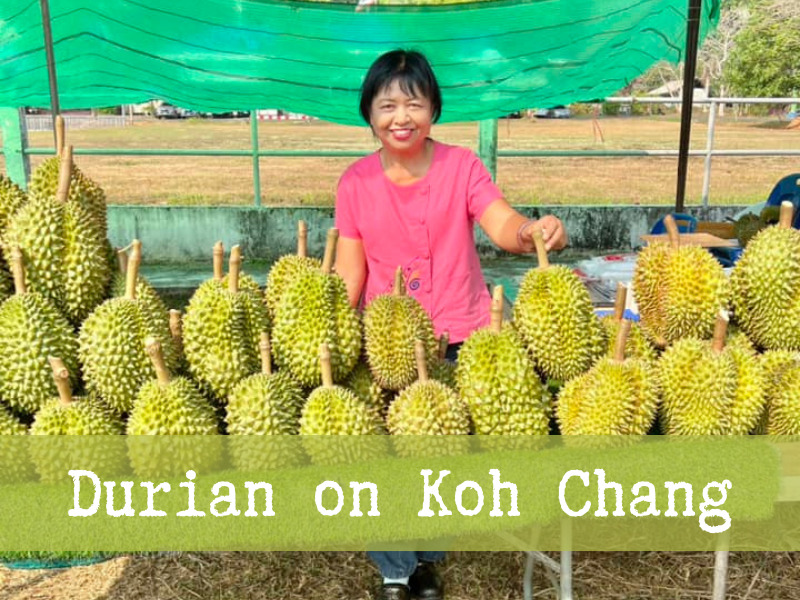Durian: A tropical delight . . . . or not?
Nestled amidst the lush landscapes of Trat and Chantaburi provinces, bountiful orchards flourish, offering a cornucopia of fruit varieties. Towering above all others in this fruity pantheon is the mighty durian, which regarded as the king of fruits.
It is nothing short of miraculous that anyone ever dared to consume a durian, given its formidable and uninviting exterior. Resembling an oversized rugby ball, the durian’s thick, spiky armor makes it not only challenging to handle but also intimidating to approach. Yet, it is the durian’s overwhelming aroma that truly sets it apart from the rest – and not in the most pleasant way.
The durian’s scent is definitely not for the faint-hearted. Some people compare it to the odor of raw sewage or rotting onions, while others describe it as sweet and fruity with notes of vanilla and almonds. (But I think they may be wrong.)

The aroma is complex and can be difficult to pinpoint, with some people detecting hints of garlic, cheese, or even gasoline. This potent aroma is so overpowering that it can linger in the air for hours, refusing to be contained or ignored. Despite its strong odor, durian is considered a delicacy in many Southeast Asian countries and is known for its rich, creamy, and slightly sweet flavor.
Despite its infamous reputation, the durian has long been a beloved fruit on Koh Chang island.
The combination of soil type and sea air provides an ideal setting for durian cultivation, and the local community has fully embraced this enigmatic fruit. Travelers seeking an authentic, immersive experience will find themselves drawn to Koh Chang’s durian orchards, where they can witness first-hand the cultivation and harvesting of this fascinating fruit.
As you embark on your journey through Koh Chang’s durian paradise, prepare to be challenged, intrigued, and perhaps even won over by this remarkable fruit that has captivated the hearts and palates of those who dare to indulge in its unique charms.

The Polarizing Aroma of Durian: Love It or Hate It?
During the main fruit season, an abundance of exquisite fruits entices the senses, from succulent mangoes to exotic mangosteens, vibrant rose apples to delicate rambutans. Amidst this fruity paradise, one might wonder why anyone would take the time and effort required to devour the notorious durian.
For many it is an acquired taste. While some may become enamored with the durian at first bite, others find their appreciation for this unique fruit growing over time. However, once this singular taste is acquired, there’s simply no turning back.
Durian aficionados embark on a pilgrimage of sorts on Koh Chang, driving along the east coast road which is lined with durian orchards to select their preferred fruit from those displayed at roadside stalls. They possess a keen sense of discernment, able to identify the perfect durian through its aroma, colour, and texture of the thorny spikes. Most crucially, they know the precise sound it should produce when tapped gently with a wooden stick.
Stallholders will always open any Durian which is bought and remove the segments. This is because mastering the art of opening a durian requires skill and patience. One must carefully navigate the seams between the intimidating spikes. Though the journey is fraught with sharp pricks from the formidable thorns, although the reward of unveiling the soft, yellow, custard-like flesh within makes the effort worthwhile.
Embrace the challenge, and you may just find yourself captivated by the unforgettable taste of this most revered fruit.

Durian Varieties on Koh Chang Island
There are well over 200 durian varieties, most of which area grown in South East Asia. Here on Koh Chang the durian on offer provide a diverse range of flavors and textures for both novice and seasoned durian enthusiasts.
Koh Chang is primarily known for its excellent Chanee durian which is the most common type grown by local farmers. It is now promoted by the Thai government with a ‘Geographical Indicator’ – GI. GIs are used worldwide to promote premium foods from specific locations. Koh Chang’s Chanee durian are known for their rich, dry flesh with yellow to light yellow-orange colouring and a and fine texture. The aroma will be sweet and fragrant – at least to durian lovers.
Every year, usually in early April, Chanee durian festival is held on the island. Farmers compete to have the best Chanee durian and hundreds of visitors, mostly Thai, head to the east of the island to buy it.
The main durian season is quite short. From late March until May. Although it is possible to get durian most of the year, however it probably won’t be grown locally.
This is an excellent video for anyone wanting to know more about how durian are grown, harvested and eaten here on Koh Chang.
As you embark on your durian adventure, also keep an eye out for these popular types:
Monthong (Golden Pillow): This is the most popular and widely cultivated durian variety in Thailand, known for its large size, creamy texture, and sweet, mild flavor. This is probably th best one to try if you have never had durian before. It isn’t as pungent as other varieties and the texture is similar to a soft apple
Kan Yao (Long Stem): This durian variety is named for its long stem and distinctive shape, and is known for its soft, delicate flesh and mild, sweet flavor.
Kop (Hoop): This durian has a thick, fibrous husk and is named for its distinctive “hoop” shape. It has a slightly bitter flavor and is often used in desserts and candies.
Thong Yod (Golden Nugget): This smaller durian variety is named for its nugget-like shape and golden color. It has a sweet, creamy flavor and is often used in desserts.
Over time, as you sample these different durian types, you may begin to discern the subtle nuances in taste and texture that make each variety unique. Some may be sweeter or smellier, while others may be mushier, meatier, crunchier or creamier.

Durian Dos and Don’ts for First-Timers
To make the most of your first durian experience, consider these three dos and don’ts:
Do keep an open mind
Durian’s notorious reputation might precede it, but it’s essential to approach this unique fruit with an open mind. Different people have different tastes, and you might find that you actually enjoy durian’s flavor and texture. Give it a fair chance without letting preconceived notions cloud your judgment.
Don’t judge the fruit by its smell alone
While the durian’s aroma can be quite potent, it’s crucial not to let the smell discourage you from tasting it. The flavor is often more subtle and complex than the smell would suggest, so try to focus on the taste rather than the odor.
Do start with a milder variety
For your first durian experience, it’s a good idea to try a milder variety like the Mongthong (Golden Pillow) to ease yourself into its unique flavor profile. As you become more accustomed to the taste, you can gradually explore stronger and more distinct varieties, such as the Chanee (Gibbon) or Kanyao (Long Stem).
Don’t eat too much at once
Durian can be quite rich and filling, so it’s advisable to start with a small portion to avoid overwhelming your taste buds or feeling too full. You can always have more if you find you enjoy it!
Do enjoy durian with friends or locals
Sharing your first durian experience with friends or locals who are familiar with the fruit can make it more enjoyable and educational. They can provide guidance on selecting the best durians, opening them, and even offer recommendations for other varieties to try or how to pair durian with other foods.
Don’t consume durian with alcohol
It’s important to avoid consuming durian with alcohol, as the combination can cause serious indigestion or other unpleasant side effects. Stick to water or other non-alcoholic beverages while enjoying your durian feast.




